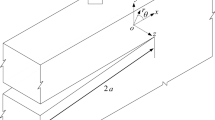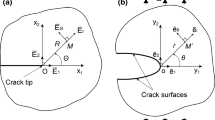Abstract
In this paper, an energy method is proposed to study the full elastic-plastic field of a tensile crack. A statically admissible stress field is established by develo** an expansion of the stress function in separable form. The unknown parameters are determined by minimizing the complementary energy of the structure. The results obtained by this method are compared with the fine finite element analysis in previous literature. This method shows some advantages for studying the elastic-plastic cracks, in the capacity to find out an algebraic expression of the stress field connecting the plastic near-tip field to the elastic far field, and in the highly accurate representation of the full elastic-plastic field surrounding the crack-tip and in the economical calculation, etc. It can also be used to evaluate some quantities in the analytical asymptotic expansion such as the amplitudes, the Q-stress etc.
Similar content being viewed by others
References
J.A. Hult and F.A. McClintock, Elastic-plastic stress and strain distribution around sharp notches under repeated shear, in Proceedings of the 9th International Congress of Applied Mechanics, University of Brussels, 8 (1957) 51–62.
J.R. Rice, Stresses due to a sharp; notch in a work-hardening elastic-plastic material loaded by longitudinal shear. Journal of Applied Mechanics, 34 (1967) 287–298.
D.S. Dugdale, Yielding of stell sheets containing slits. Journal of the Mechanics and Physics of Solids 8 (1960) 100–104.
J.W. Hutchinson, Singular behavior at the end of a tensile crack in a hardening material. Journal of the Mechanics and Physics of Solids 16 (1968) 13–31.
J.R. Rice and G.F. Rosengren, Plane strain deformation near a crack tip in a power-law hardening material. Journal of the Mechanics and Physics of Solids 16 (1968) 1–12.
J.R. Rice, A path independent integral and the approximate analysis of strain concentrations by notches and cracks. Journal of Applied Mechanics, 35 (1968) 379–386.
J.A. Begley and J.D. Landes, The J-integral as a Fracture criterion in fracture toughness testing. ASTM STP 514 (1972) 1–23, 24–39.
C.F. Shih, H.G. de Lorenzi and W.R. Andrews, Studies on crack initiation and stable crack growth. ASTM STP 668 (1979) 65–120.
R.M. McMeeking, Finite deformation analysis of crack-tip opening in elastic-plastic materials and implications for fracture. Journal of the Mechanics and Physics of Solids 25 (1977) 357–381.
R.M. McMeeking and D.M. Parks, On criteria for J-dominance of crack tip fields in large scale yielding. ASTM STP 668 (1979) 175–194.
A. Needleman and V. Tvergaard, Crack-tip stress and deformation fields in a solid with a vertex on its yield surface. ASTM STP 803 (1983) I-80–I-115.
Y. Li and Z. Wang, High-order asymptotic field of tensile plane-strain nonlinear crack problems. Scientia Sinica, A9 (1986) 941–955.
S.M. Sharma and N. Aravas, Determination of higher-order terms in asymptotic elastoplastic crack tip solutions. Journal of the Mechanics and Physics of Solids 39 (1991) 1043–1072.
N.P. O'Dowd and C.F. Shih, Family of crack-tip fields characterized by a triaxiality parameter — I. Structure of fields. Journal of the Mechanics and Physics of Solids 39 (1991) 989–1015.
L. **a, Wang and C.F. Shih, Higher-order analysis of crack tip fields in elastic power-law hardening materials. Journal of the Mechanics and Physics to Solids 41 (1993) 665–687.
S. Yang, Y.J. Chao and M.A. Sutton, Higher order asymptotic crack tip fields in a power-law hardening material. Engineering Fracture Mechanics 45 (1993) 1–20.
Y. Wei and T. Wang, Characterization of elastic-plastic fields near stationary crack tip and fracture criterion. Engineering Fracture Mechanics 51 (1995) 547–553.
T.M. Edmunds and J.R. Willis, Matched asymptotic expansions in nonlinear fracture mechanics — I. Longitudinal shear of an elastic perfectly-palstic specimen. Journal of the Mechanics and Physics of Solids 24 (1976) 205–223.
T.M. Edmunds and J.R. Willis, Matched asymptotic expansions in nonlinear fracture mechanics — II. Longitudinal shear of an elastic work-hardening plastic specimen. Journal of the Mechanics and Physics of Solids 24 (1976) 225–237.
T.M. Edmunds and J.R. Willis, Matched asymptotic expansions in nonlinear fracture mechanics — III. In-plan loading of an elastic perfectly-plastic symmetric specimen. Journal of the Mechanics and Physics of Solids 24 (1977) 423–455.
M.L. Williams, On the stress distribution at the base of a stationary crack. Journal of the Mechanics and Physics of Solids 24 (1957) 111–114.
Author information
Authors and Affiliations
Rights and permissions
About this article
Cite this article
Jia, L. Determination of the full elastic-plastic stress field of a tensile crack by minimization of the complementary energy. International Journal of Fracture 84, 1–17 (1997). https://doi.org/10.1023/A:1007398415605
Issue Date:
DOI: https://doi.org/10.1023/A:1007398415605




